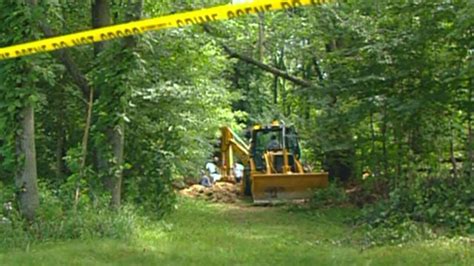
Human remains have been discovered near the former property of Herb Baumeister, a man who died by suicide in 1996 while under investigation for a string of murders in the Indianapolis area. The bones were found along a creek bed on the Fox Hollow Farm property in Westfield, Indiana, renewing interest in a case that has haunted investigators for decades.
Westfield Police Department announced the grim discovery, stating that the Hamilton County Coroner’s Office is working to identify the remains. Authorities have been searching portions of the former Baumeister property since the 1990s, initially uncovering remains believed to belong to victims of Baumeister, who frequented gay bars in Indianapolis.
“Based on the amount of bones found, this will be a lengthy process,” said Cindy Benedict, Public Information Officer for the City of Westfield. The investigation aims to determine the number of individuals represented by the bones and potentially link them to previously unidentified victims.
The Baumeister Case: A Dark Chapter in Indiana History
Herbert “Herb” Baumeister became a suspect in the mid-1990s after police investigated the disappearances of several men in the Indianapolis area. Many of these men were last seen at gay bars, a detail that raised suspicions and ultimately led investigators to Baumeister’s 18-acre estate, Fox Hollow Farm.
Baumeister and his wife, Juliana, lived on the property with their three children. While initially cooperating with the police, Baumeister became increasingly evasive as the investigation progressed. Detectives, acting on a tip and after obtaining a search warrant, began excavating the property in 1996. The search uncovered cremated remains and bone fragments, leading investigators to suspect Baumeister of being a serial killer.
Rather than face arrest and prosecution, Baumeister fled to Canada and died by suicide. He left behind a note denying involvement in the disappearances, but the evidence found on his property told a different story. Despite the findings, many questions surrounding the case remained unanswered, including the exact number of Baumeister’s victims and their identities.
Initial Searches and Findings
The initial searches of Fox Hollow Farm in 1996 yielded skeletal remains that were eventually linked to several missing men. Investigators at the time believed that Baumeister lured his victims to his property, where he murdered them and disposed of their bodies by burning or burying them in the woods surrounding his home.
“During the initial investigation in the 1990s, the remains of at least 11 men were found on the property,” stated a previous report from the Hamilton County Sheriff’s Office. The remains were crucial in piecing together the timeline of Baumeister’s alleged crimes and provided some closure to the families of the victims. However, due to the condition of the remains, not all of them could be positively identified.
The Case’s Lingering Questions
Despite the initial findings, the Baumeister case has been plagued by lingering questions and unresolved leads. The dense, wooded terrain of Fox Hollow Farm made it difficult for investigators to thoroughly search the entire property. Moreover, the passage of time and the condition of the remains complicated the identification process.
Family members of missing men have continued to seek answers, hoping to find closure and bring their loved ones home. The recent discovery of additional bones near the creek bed offers a renewed opportunity to potentially identify additional victims and shed light on the full extent of Baumeister’s alleged crimes.
Renewed Investigation and Current Findings
The recent discovery of human remains prompted a renewed investigation into the Baumeister case. Law enforcement officials are meticulously examining the bones to determine their origin, age, and any potential links to previously unidentified missing persons.
“The Hamilton County Coroner’s Office is working to identify the remains, and the Westfield Police Department is assisting in the investigation,” Cindy Benedict stated. The investigation involves forensic analysis, DNA testing, and collaboration with experts in anthropology and forensic science.
The discovery of bones near the creek bed suggests that Baumeister may have used the waterway to dispose of remains, further complicating the search efforts. The dense vegetation and challenging terrain surrounding the creek make the recovery process slow and painstaking.
Challenges in Identifying Remains
One of the main challenges in the investigation is identifying the remains. Over the years, exposure to the elements and natural decomposition have degraded the bones, making it difficult to extract DNA and conduct forensic analysis.
Additionally, the lack of dental records and other identifying information for some of the missing men makes it difficult to positively match the remains with potential victims. Investigators are relying on advanced forensic techniques and historical records to piece together the identities of the deceased.
Impact on Victims’ Families
The discovery of additional remains has had a profound impact on the families of the victims. For some, it offers a glimmer of hope that they may finally be able to find closure and bring their loved ones home. For others, it stirs up painful memories and renews the anguish of not knowing what happened to their family members.
“The families of the missing men have been waiting for answers for decades,” said a representative from a victim advocacy group. “This discovery is a reminder of the toll that Baumeister’s alleged crimes have taken on the community.”
Community Reaction
The discovery of human remains near the Baumeister property has generated widespread interest and concern in the community. Many residents remember the original investigation and the fear that gripped the area during the mid-1990s. The renewed investigation has brought those memories back to the surface, prompting a mix of emotions, including sadness, anger, and a desire for justice.
Local news outlets have been closely following the investigation, providing regular updates to the public. Residents have expressed their support for the victims’ families and their hope that the investigation will finally bring closure to this dark chapter in Indiana history.
The Role of Forensic Science
Forensic science plays a crucial role in the investigation of the Baumeister case. Experts in forensic anthropology, DNA analysis, and other related fields are working to extract as much information as possible from the remains.
Forensic anthropologists examine the bones to determine their age, sex, and any signs of trauma or injury. DNA analysts attempt to extract DNA from the bones and compare it to DNA samples from potential victims or their family members. Other forensic specialists may examine the bones for evidence of tool marks or other clues that could shed light on the circumstances surrounding the deaths.
The information gathered through forensic analysis is essential for identifying the remains and piecing together the events that led to the victims’ deaths.
Legal Implications
The discovery of additional remains could have significant legal implications for the Baumeister case. While Baumeister is deceased and cannot be prosecuted, the identification of additional victims could provide further evidence of his crimes and help to establish the full extent of his culpability.
Additionally, the investigation could potentially uncover new leads or information that could lead to other suspects or accomplices. Law enforcement officials are committed to pursuing all possible avenues of investigation to ensure that justice is served for the victims and their families.
The Future of the Investigation
The investigation into the discovery of human remains near the Baumeister property is ongoing. Law enforcement officials are committed to conducting a thorough and comprehensive investigation to identify the remains and bring closure to the victims’ families.
The investigation will likely involve additional searches of the property, forensic analysis of the remains, and interviews with witnesses and experts. The goal is to gather as much information as possible to understand the full extent of Baumeister’s alleged crimes and ensure that justice is served.
The Baumeister case serves as a chilling reminder of the devastating impact of serial killers and the importance of law enforcement’s efforts to bring them to justice. The discovery of additional remains underscores the need for continued vigilance and a commitment to solving cold cases and providing closure to the families of missing persons.
The Broader Context of Serial Murder Investigations
The Baumeister case is not unique in the annals of criminal history. Serial murder investigations often involve complex forensic analysis, extensive searches for victims, and the challenge of identifying remains that may have been buried or hidden for years.
Cases like the Green River Killer, the Golden State Killer, and the BTK Killer highlight the dedication and perseverance required to solve these types of crimes. Law enforcement agencies often collaborate with forensic experts, behavioral scientists, and other specialists to build a profile of the perpetrator, identify potential victims, and gather evidence that can be used in court.
The investigation of serial murder cases can be emotionally taxing for investigators, who must confront the depravity of the crimes and the suffering of the victims’ families. However, their commitment to justice and their determination to bring closure to the victims’ families often drive them to pursue these cases relentlessly.
The Evolving Landscape of Forensic Science
The field of forensic science has advanced significantly in recent years, providing investigators with new tools and techniques for solving crimes. DNA analysis, for example, has become an indispensable tool for identifying remains, linking suspects to crime scenes, and exonerating the wrongly accused.
Other advancements in forensic science, such as digital forensics, ballistics analysis, and trace evidence analysis, have also played a crucial role in solving complex criminal cases. As technology continues to evolve, forensic science is likely to play an even greater role in the investigation and prosecution of crimes.
The Importance of Collaboration and Communication
Effective collaboration and communication are essential for solving complex criminal cases like the Baumeister case. Law enforcement agencies must work closely with forensic experts, victim advocacy groups, and other stakeholders to gather information, share resources, and coordinate their efforts.
Communication with the public is also crucial. Keeping the community informed about the progress of the investigation can help to build trust, encourage cooperation, and prevent the spread of misinformation.
The Lasting Impact of Unsolved Cases
Unsolved cases can have a lasting impact on communities and families. The uncertainty and lack of closure can lead to anxiety, fear, and a sense of injustice. Families of missing persons often experience profound grief and may struggle to cope with the loss of their loved ones.
Law enforcement agencies have a responsibility to continue investigating unsolved cases and to provide support to the families of victims. Cold case units, which are dedicated to investigating unsolved crimes, can play a crucial role in bringing closure to families and ensuring that justice is served.
The Ethics of Serial Killer Investigations
Serial killer investigations raise a number of ethical considerations for law enforcement officials, forensic experts, and the media. It is important to balance the public’s right to know with the need to protect the privacy of victims and their families.
Investigators must also be careful not to sensationalize the crimes or to glorify the perpetrators. The focus should always be on the victims and their families, and on bringing the perpetrators to justice.
The Role of the Media in Reporting Crime
The media plays a vital role in reporting crime and keeping the public informed. However, it is important for journalists to adhere to ethical standards and to avoid sensationalizing crimes or glorifying perpetrators.
The media should also be sensitive to the needs of victims and their families. Reporting should be accurate, fair, and respectful.
The Baumeister Case: A Reflection on Society
The Baumeister case serves as a reflection on society’s attitudes towards marginalized groups, such as gay men. The fact that Baumeister targeted gay men suggests that he may have been motivated by prejudice or homophobia.
It is important to recognize and address the underlying social issues that contribute to violence and discrimination against marginalized groups. By creating a more inclusive and tolerant society, we can help to prevent future tragedies like the Baumeister case.
The Power of Hope and Resilience
Despite the darkness and tragedy of the Baumeister case, there is also a story of hope and resilience. The families of the victims have demonstrated remarkable strength and perseverance in their search for answers and closure.
Their unwavering commitment to justice and their determination to honor the memory of their loved ones is an inspiration to us all.
FAQ:
-
What was found near the former Baumeister property? Human remains, specifically bones, were discovered near a creek bed on the former Fox Hollow Farm property, once owned by Herb Baumeister.
-
Who was Herb Baumeister, and why is this discovery significant? Herb Baumeister was a man who died by suicide in 1996 while under investigation for the murders of several men who frequented gay bars in Indianapolis. The discovery is significant because it could potentially identify additional victims of Baumeister and provide closure to their families. Initial searches in the 1990s led to the discovery of remains of at least 11 men.
-
What is the current status of the investigation? The Hamilton County Coroner’s Office is working to identify the remains, with assistance from the Westfield Police Department. The investigation involves forensic analysis, DNA testing, and collaboration with experts in anthropology and forensic science. Cindy Benedict, Public Information Officer for the City of Westfield, stated that “based on the amount of bones found, this will be a lengthy process.”
-
What challenges are investigators facing in identifying the remains? Challenges include the degradation of the bones over time due to exposure to the elements and natural decomposition, making it difficult to extract DNA. Additionally, the lack of dental records and other identifying information for some of the missing men complicates the process of matching the remains with potential victims.
-
How has the discovery impacted the families of the missing men? The discovery has had a profound impact on the families, offering a glimmer of hope for some that they may finally find closure and bring their loved ones home. For others, it stirs up painful memories and renews the anguish of not knowing what happened to their family members.
Expanded Analysis and Context:
The discovery of human remains near the former property of Herb Baumeister reopens a painful chapter in Indiana’s history, forcing a community to confront unresolved grief and grapple with the legacy of a man suspected of being a serial killer. While the initial searches of Fox Hollow Farm in the mid-1990s yielded the remains of at least 11 men, many questions remained unanswered, leaving families in a state of perpetual uncertainty. This recent discovery underscores the enduring nature of these cold cases and the persistent hope for identification and closure.
The renewed investigation faces significant challenges. The passage of time has undoubtedly impacted the condition of the remains, making DNA extraction and identification more difficult. The initial searches, while extensive, were likely hampered by the dense, wooded terrain of the property. The current investigation will need to employ advanced forensic techniques, including isotope analysis, which can provide insights into the geographic origins and dietary habits of the deceased, potentially aiding in narrowing down the pool of possible victims. Additionally, advancements in DNA technology may allow for the identification of remains that were previously unidentifiable due to degradation or limited sample size.
The psychological impact on the families of the missing men cannot be overstated. The discovery of additional remains, even after so many years, can trigger a complex mix of emotions, including hope, fear, grief, and anger. For some, it may offer a sense of relief, knowing that their loved one has finally been found. For others, it may reopen old wounds and force them to confront the unresolved trauma of their loss. It is crucial that these families receive adequate support and resources during this difficult time, including counseling, grief support groups, and access to information about the investigation.
The Baumeister case also raises broader societal questions about the targeting of marginalized groups. Baumeister’s alleged victims were primarily gay men, a group that has historically faced discrimination and violence. The case highlights the importance of addressing homophobia and prejudice in our society and ensuring that all individuals are treated with dignity and respect. It also underscores the need for law enforcement agencies to be sensitive to the needs of marginalized communities and to ensure that they are treated fairly and equitably.
The media’s role in covering the Baumeister case is also significant. While it is important to keep the public informed about the investigation, it is equally important to avoid sensationalizing the crimes or glorifying the perpetrator. The focus should always be on the victims and their families, and on providing accurate and respectful coverage of the investigation. The media also has a responsibility to avoid perpetuating harmful stereotypes or biases that could further stigmatize marginalized groups.
The legal implications of the discovery are complex. While Baumeister is deceased and cannot be prosecuted, the identification of additional victims could provide further evidence of his crimes and potentially lead to civil lawsuits against his estate. It could also shed light on whether anyone else was involved in the murders, potentially leading to new leads and avenues of investigation. The authorities have an ethical obligation to pursue all possible leads and to ensure that justice is served for the victims and their families.
The Baumeister case also highlights the importance of cold case units and the ongoing efforts to solve unsolved crimes. These units play a crucial role in bringing closure to families and ensuring that justice is served, even after many years have passed. They often utilize advanced forensic techniques and rely on the dedication and perseverance of investigators who are committed to solving these complex and challenging cases.
The discovery of human remains near the Baumeister property serves as a stark reminder of the enduring impact of violent crime and the importance of our collective efforts to prevent future tragedies. By addressing the underlying social issues that contribute to violence and discrimination, supporting the families of victims, and investing in forensic science and law enforcement, we can create a safer and more just society for all.
Additional Points to Elaborate On:
-
The Nature of Baumeister’s Crimes: Herb Baumeister’s alleged modus operandi involved luring men, primarily from gay bars in Indianapolis, to his sprawling estate. He presented himself as wealthy and successful, gaining their trust before allegedly murdering them. The fact that he targeted gay men speaks to the historical vulnerability of this community and the prejudices they faced, which Baumeister may have exploited.
-
The Challenge of Searching Fox Hollow Farm: Fox Hollow Farm’s expansive 18-acre property, characterized by dense woodlands and a creek, presented significant logistical challenges to investigators. The dense vegetation and uneven terrain made searching difficult and time-consuming. The creek could have been used by Baumeister to dispose of remains, complicating the search efforts further. The initial search in the 1990s was limited by the technology and resources available at the time.
-
The Role of Forensic Anthropology: Forensic anthropologists are crucial in analyzing the discovered remains. They can determine the age, sex, ancestry, and stature of the individuals, as well as identify any signs of trauma or disease. This information can help narrow down the list of potential victims and provide valuable clues about the circumstances surrounding their deaths.
-
DNA Analysis and Technological Advancements: Advancements in DNA technology have revolutionized forensic science. Even highly degraded DNA samples can now be analyzed using techniques such as mitochondrial DNA sequencing. This is particularly important in cold cases like the Baumeister case, where the remains may be old and fragmented. DNA profiling can also be used to compare the remains to DNA samples from potential victims’ family members, providing a definitive identification.
-
Isotope Analysis as a Forensic Tool: Isotope analysis is a powerful tool that can be used to determine the geographic origin and dietary habits of individuals based on the isotopic composition of their bones and teeth. This information can be particularly useful in identifying victims who may have moved to Indianapolis from other areas.
-
The Importance of Victim Advocacy Groups: Victim advocacy groups play a vital role in supporting the families of missing and murdered individuals. They provide emotional support, legal assistance, and advocacy services. These groups can also help to raise awareness about cold cases and advocate for increased resources for law enforcement.
-
The Ethical Considerations of Identifying Victims: The process of identifying human remains can be emotionally challenging for the families of missing individuals. It is important to handle the process with sensitivity and respect, providing families with clear and accurate information throughout the investigation. It is also crucial to protect the privacy of the victims and their families.
-
The Baumeister Case in the Context of Serial Killer History: The Baumeister case is part of a larger history of serial murder in the United States. Serial killers often target vulnerable populations and exploit societal prejudices. Understanding the motivations and methods of serial killers is essential for preventing future tragedies.
-
The Role of Community Involvement in Cold Cases: Community involvement can be crucial in solving cold cases. Individuals who may have information about the case, even if they believe it is insignificant, are encouraged to come forward and share it with law enforcement. The public can also help to raise awareness about cold cases and advocate for increased resources for law enforcement.
-
The Psychological Impact on Investigators: Investigating cold cases can be emotionally taxing for law enforcement officers. They must confront the horrors of the crimes and the suffering of the victims’ families. It is important for investigators to have access to counseling and support services to help them cope with the psychological demands of their work.
-
The Long-Term Effects on the Community: The Baumeister case has had a lasting impact on the Indianapolis community. It has raised awareness about the vulnerability of marginalized groups and the importance of addressing societal prejudices. The case has also led to increased efforts to support the families of missing and murdered individuals.
-
The Potential for New Leads and Information: Even after many years, there is still the potential for new leads and information to emerge in the Baumeister case. Witnesses may come forward with new information, or advancements in forensic technology may provide new insights. Law enforcement remains committed to pursuing all possible leads and ensuring that justice is served for the victims and their families.
-
The Importance of Documenting and Preserving Evidence: Proper documentation and preservation of evidence are crucial in cold cases. Evidence that was collected during the initial investigation may become more valuable as forensic technology advances. It is important to ensure that all evidence is properly stored and maintained so that it can be re-examined if necessary.
-
The Role of Technology in Cold Case Investigations: Technology plays an increasingly important role in cold case investigations. Computer databases, facial recognition software, and social media analysis can all be used to identify potential victims and suspects. Law enforcement is continually adapting to new technologies and utilizing them to solve cold cases.
-
The Power of Hope and Perseverance: The Baumeister case is a reminder of the power of hope and perseverance. Despite the challenges and setbacks, the families of the victims have never given up hope that their loved ones will be found and that justice will be served. Their unwavering commitment to finding answers is an inspiration to us all.
By expanding on these points, the article can provide a more comprehensive and nuanced understanding of the Baumeister case and its implications.
Further Elaboration on Specific Points:
1. Baumeister’s Modus Operandi and Exploitation of Prejudice:
Baumeister’s method of operation suggests a calculated predator who exploited the vulnerabilities of a specific community. The Indianapolis gay bar scene in the 1990s, while a space of relative freedom and acceptance, also presented an environment where men might be more susceptible to advances from someone perceived as wealthy and sophisticated. Baumeister used this perception to gain trust, drawing his victims back to his isolated estate. This pattern highlights the insidious nature of prejudice and how it can be weaponized by individuals seeking to inflict harm. It underscores the need for ongoing efforts to combat homophobia and ensure the safety and well-being of LGBTQ+ individuals. It’s also worth noting the power imbalance – Baumeister, a married businessman with a family, held a position of relative privilege compared to some of the men he targeted.
2. The Initial Search and the Challenges of the Terrain:
The initial search of Fox Hollow Farm was a monumental undertaking, but one that was inevitably limited by the resources and technology available at the time. The 18-acre property presented a complex landscape, with dense woodlands offering ample opportunities for concealment. The presence of a creek added another layer of difficulty, as bodies or remains could have been washed away or buried along the banks. Ground-penetrating radar, a technology that is now more commonly used in forensic investigations, might not have been readily available or as advanced in the 1990s. Furthermore, the sheer volume of earth that needed to be excavated made the search a painstaking and time-consuming process. This underscores the importance of revisiting cold cases as new technologies and techniques become available.
3. The Nuances of Forensic Anthropology:
Forensic anthropology goes beyond simply identifying skeletal remains. Skilled forensic anthropologists can analyze bones for signs of trauma, such as fractures or cut marks, which can provide clues about the cause of death. They can also estimate the time since death based on the condition of the bones and the surrounding environment. In the Baumeister case, forensic anthropologists might be able to determine whether the victims were subjected to any form of torture or abuse before their deaths. They can also analyze skeletal variations to help narrow down the list of potential victims, especially if there are any unique features or anomalies.
4. The Evolutionary Power of DNA Analysis:
DNA analysis has undergone a remarkable evolution in recent years. Techniques such as mitochondrial DNA sequencing allow scientists to analyze DNA from extremely degraded samples, such as bones that have been exposed to the elements for many years. This is particularly important in cold cases like the Baumeister case, where traditional DNA profiling methods may not be effective. Furthermore, advancements in DNA databases and genealogical research have made it possible to identify victims even if there are no direct family matches. By comparing DNA profiles from the remains to publicly available genealogical databases, investigators may be able to identify distant relatives and trace the victim’s lineage.
5. Isotope Analysis: Tracing Origins and Habits:
Isotope analysis is a fascinating forensic tool that can provide insights into the geographic origins and dietary habits of individuals. Different regions of the world have unique isotopic signatures in their soil and water. These signatures are incorporated into the bones and teeth of individuals who live in those regions. By analyzing the isotopic composition of the remains, forensic scientists can determine where the victims spent their childhoods and whether they had migrated to Indianapolis from other areas. Similarly, the isotopic composition of the remains can provide clues about their diet, such as whether they consumed a lot of meat or seafood.
6. The Multifaceted Support Provided by Victim Advocacy Groups:
Victim advocacy groups provide a range of essential services to the families of missing and murdered individuals. These services include emotional support, counseling, legal assistance, and advocacy. They can help families navigate the complex legal system, access resources, and cope with the emotional trauma of their loss. They also advocate for increased funding for law enforcement and for policies that protect the rights of victims. In the Baumeister case, victim advocacy groups have played a crucial role in keeping the case alive and ensuring that the victims are not forgotten.
7. Ethical Considerations in Identifying Remains with Sensitivity:
The process of identifying human remains is fraught with ethical considerations. It is essential to treat the victims with dignity and respect throughout the investigation. Law enforcement officials must also be sensitive to the needs of the families and provide them with clear and accurate information about the process. They should avoid sensationalizing the crimes or releasing details that could cause further pain and suffering to the families. Protecting the privacy of the victims and their families is also of paramount importance.
8. Contextualizing the Baumeister Case within Serial Killer History:
The Baumeister case is part of a broader history of serial murder in the United States. Serial killers are often motivated by a combination of factors, including psychological disorders, social isolation, and a desire for power and control. They often target vulnerable populations, such as sex workers, runaways, and LGBTQ+ individuals. Understanding the motivations and methods of serial killers is essential for preventing future tragedies. By studying past cases, law enforcement can develop strategies for identifying and apprehending serial killers before they can claim more victims.
9. Leveraging Community Involvement and Public Awareness:
Community involvement can be a critical factor in solving cold cases. Individuals who may have information about the case, even if they believe it is insignificant, are encouraged to come forward and share it with law enforcement. This can include eyewitness accounts, memories of suspicious activity, or even old photographs or documents. Raising public awareness about the case can also generate new leads and encourage people to come forward with information. Social media can be a powerful tool for disseminating information and engaging the community in the investigation.
10. The Emotional Toll on Cold Case Investigators:
Investigating cold cases can be emotionally challenging for law enforcement officers. They are often confronted with the worst aspects of human nature and must deal with the grief and suffering of the victims’ families. The lack of closure in these cases can also be frustrating and demoralizing. It is important for investigators to have access to counseling and support services to help them cope with the psychological demands of their work. Peer support groups can also provide a safe space for investigators to share their experiences and receive encouragement from others who understand the challenges they face.
By further elaborating on these points, the article can provide a more in-depth and nuanced understanding of the Baumeister case and its implications.









